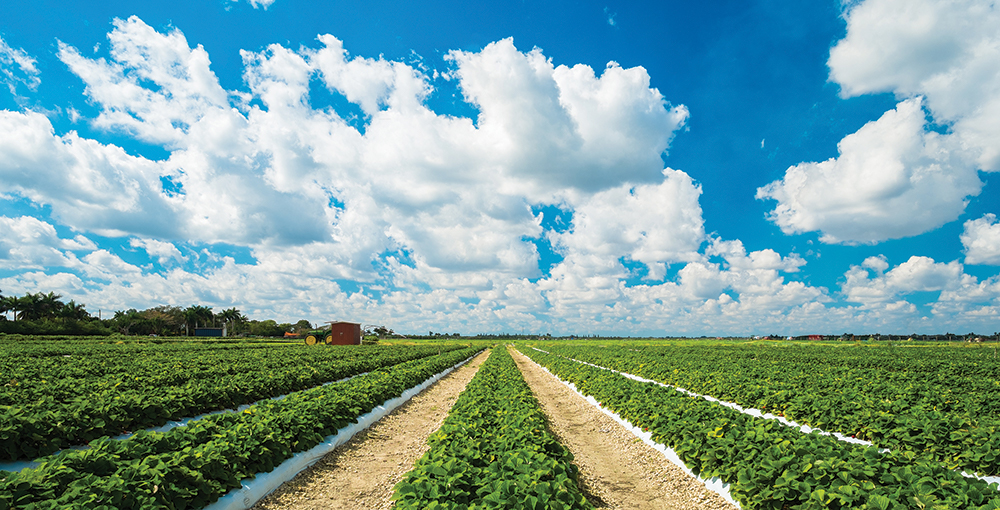The State of the 2020 Strawberry Season and What It Means for Florida Growers
by TERESA SCHIFFER
The strawberry season got off to a slow start in November, but volume is picking up and growers are smiling. While the quality level has been acceptable, berry size has been on the small side. Growers are expecting the berries to get larger as the season continues. Some farms got a late start planting because of cold weather in the fall, contributing to the delay in picking. Despite these minor setbacks, there have been more berries picked this year than last year at the same time, and while they have brought a good price, the price is lower than last year due to the difference in volume. We talked with Carl Grooms, owner of Fancy Farms in Plant City, for some insight as to how the industry is faring this season overall.
“The season this year is going fairly decent,” Grooms says.
“We’ve actually, industry-wide, picked more berries than we did last year. We’re not making quite as much money on average per container, but it’s OK, and we’re going to get into the peak season here in the next couple of weeks and pick a lot of berries. We’re looking forward to that.”
Strawberry plants that are put in the ground in late September and the first half of October begin producing harvestable fruit around Thanksgiving and continue to do so until March.
The Florida Brilliance strawberry variety is sweeping the scene in farmers’ fields this year. This was the first year for widespread planting of the new variety, and like many other growers, Fancy Farms chose to plant 80 percent of their fields with Brilliance, and the other 20 percent with Sweet Sensation. Sweet Sensation has been in the fields for about four years now, and has pleased growers and marketers with its sweeter taste and longer shelf life, as compared to some other cultivars.
Expectations are high for Brilliance, but growers are waiting to see how the berry performs throughout the warmer weather of March before passing final judgement. The cultivar was developed by Dr. Vance Whitaker, Associate Professor of Horticulture, with the University of Florida’s horticultural research team at the GCREC (Gulf Coast Research Center) Balm Center. UF/IFAS also developed the Sweet Sensation variety, which was released commercially in the 2014-2015 growing season.
Fancy Farms was fortunate to not experience any major setbacks this season. Of course, there are a multitude of minor issues to deal with on any farm, including nutritional deficiencies, uncooperative weather, and pests. One problem facing many strawberry growers this season has been the emergence of a new fungus in Florida—the Pestalotiopsis fungus—that affects their crops. The fungus can be found on almost every farm in at least some fields, and is believed to have been spread to strawberries from other plants at nurseries in other states.
Fortunately, the damage has been minimal thus far.
“It’s far from a catastrophic problem at this point,” assesses Grooms, “but then again, we don’t know how severe it could get over the next couple of months.”
Pestalotiopsis begins its destruction by killing the leaves and then can spread throughout the foliage, fruit, and into the roots, thereby killing the entire plant.
Researchers have not yet had enough time to develop a fungicide to combat this blight. Organic farmers tend to be more severely affected by this type of issue because they are limited on what fungicides and pesticides they can use while maintaining their “organic” standard. This particular fungus is spread by water and thrives in warm temperatures. Since December was warm and wet, conditions were ripe for Pestalotiopsis to really take off.
So far, the harvest has been good at Fancy Farms, but they are still waiting to see how the rest of the season plays out. Overall, the strawberry industry can be a fickle business.
“There will be some growers that probably make the most money they’ve ever made, and there will be some that don’t make a bit of money,” Grooms says, “but that’s typical for any given year in the strawberry industry.”
Luck plays a major role in the fiscal outcome for any particular farm. In the 47 years that Grooms himself has been growing, he states that no two years have been the same. It is very difficult to predict what each season will bring in terms of profit, which can make budgeting and planning for the next year a real challenge. Adding to the strawberry growers’ stress is the fact that there are no government subsidies to assist them. Insurance is also not available for strawberry crops, either.
As we look into the future of Florida’s strawberry growers, Grooms emphasizes the importance of drawing more young people into the agricultural industry, despite the obstacles. “It’s such a hard business to get into, financially, that they can hardly do it,” explains Grooms.
“My son couldn’t do it unless I farmed, and he just stepped in behind me.” His son, Dustin Grooms, currently manages Fancy Farms. Strawberries aren’t the only crop affected by the shortage of up-and-coming farmers. Beans, squash, cucumbers, and other crops are also struggling to maintain an appropriate influx of young growers. In order to ensure the stability of our food production system, we as a society may need to investigate ways to entice more young adults to take up a career in agriculture, and remove some of the roadblocks to them doing so.

